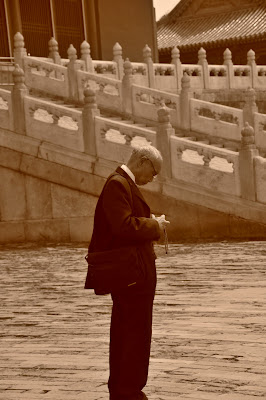
A Chinese Woman at the Forbidden City

A vendor at the Great Wall

A lady selling dried fruit at the Great Wall
Culture is defined here as a set of distinctive material, intellectual, emotional, and spiritual features of a social group, including art, literature, sport, lifestyles, value systems, traditions, rituals, and beliefs. The link between human biology and human behavior and culture is often very close, making it difficult to clearly divide topics into one area or the other; as such, the placement of some subjects may be based primarily on convention. Culture consists of values, social norms, and artifacts. A culture's values define what it holds to be important or ethical. Closely linked are norms, expectations of how people ought to behave, bound by tradition. Artifacts, or material culture, are objects derived from the culture's values, norms, and understanding of the world.

A man yelling on his mobile phone in the Forbidden City with an annoyed companion

An elderly woman in the Forbidden City

The husband of the elderly lady with his camera
Contrasting the Chinese are tourists on the Turkish Coast in Belek.

Two German ladies on the beach in Belek, Turkey


A Kazakh mother and son

A Russian man on shores of the Med

A European woman enjoying the Turkish coast














